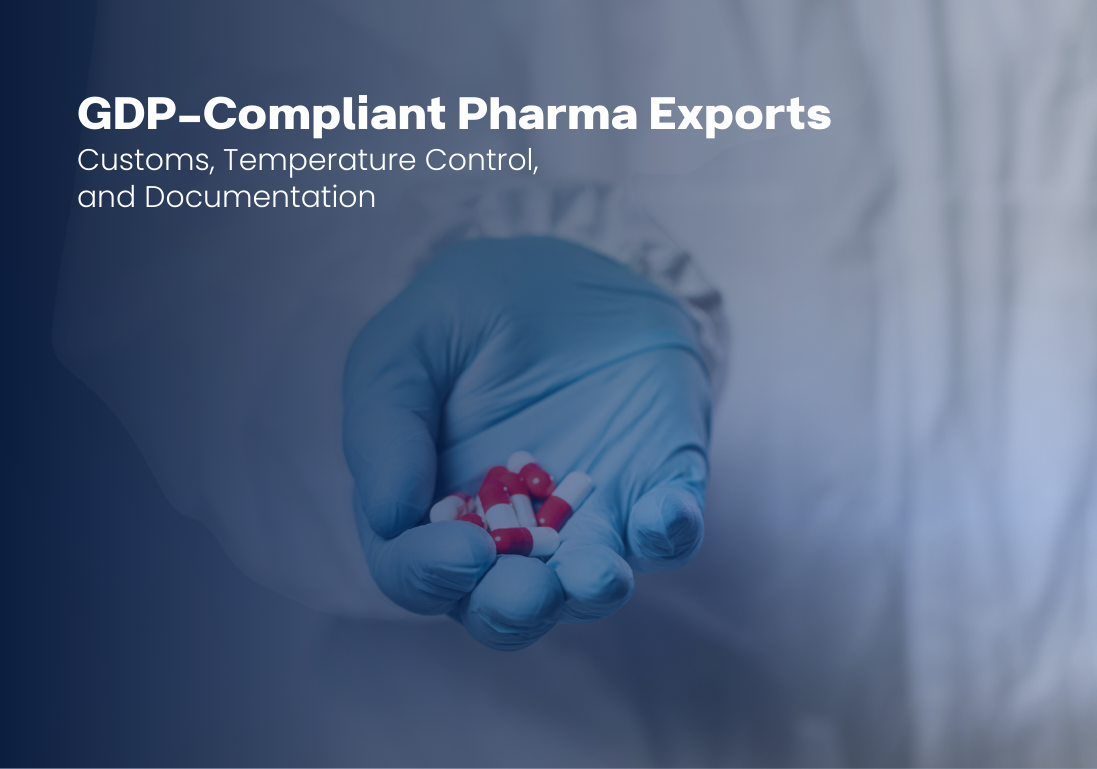Why GDP Compliance Defines Pharma Export Logistics in 2025
Pharmaceutical exports live or die on control and traceability. A batch can clear a manufacturing quality release yet fail at the border or on the apron if temperature integrity, chain‑of‑custody, or documentation is incomplete. In today’s markets, regulators, payers, and patients expect GDP‑compliant continuity from factory gate to foreign consignee. That means aligning GDP compliance pharma export logistics guidelines, mastering customs clearance for pharmaceuticals, and engineering cold chain exports that withstand real‑world shocks.
What does GDP mean in an Export Context?
Good Distribution Practice (GDP) establishes the baseline for the storage, handling, transportation, and documentation of medicinal products. For exports, GDP extends beyond national borders: the shipment must remain within labelled temperature ranges, pass verifiable custody handoffs, and retain a complete audit trail recognized by both origin and destination authorities, which requires qualified packaging, validated lanes, trained personnel, and data that proves the product’s integrity at every step.
Designing a Temperature‑Secure Export Journey
The best cold chain exports begin with a stability‑led packaging decision. MAP studies and product stability data should determine whether passive systems (phase-change materials with VIPs) or active containers (compressor-based units) are appropriate, given the route duration and risk. Origin site processes must precondition packs correctly, place calibrated data loggers, and seal tamper‑evident cartons. At the airport, minimize the tarmac gap with cool dollies and priority handling. In transit, use carriers that support pharma priority programs and provide ULD build‑up in controlled environments.
Customs Clearance for pharmaceuticals Without Delays
Customs is not only about tariffs; it is about proving product legitimacy, safety, and regulatory alignment. Accurate HS classification reduces queries. Commercial invoices must mirror batch and lot data on the packing list and Certificate of Analysis. Many destinations require import, licenses, marketing authorization references, or special permits for controlled substances. Where possible, enable pre‑arrival document submission so authorities can review before wheels‑down. The fastest lanes pair complete, reconciled documentation with a broker who understands pharmaceutical rules in both jurisdictions.
Documentation that Stands Up to Audits
Export documentation should tell a single source of truth. A typical packet includes a commercial invoice, packing list, CoA per lot, temperature mapping qualification, shipper validation, shipper SOP references, waybill, country‑specific permits, and a stability statement that justifies the labelled temperature range. Data loggers should be serialized and mapped to outer cartons on the packing list. Post‑delivery, release the logger traces to confirm compliance. Any deviations must be investigated with root‑cause analysis and documented in CAPA; some authorities may request this before releasing subsequent consignments.
Lane Risk Assessment: from Spreadsheet to Living Model
GDP expects you to know the risk of a route before you ship. A robust lane risk assessment blends historical performance data, airport handling capability, climate seasonality, carrier reliability, connection dwell times, and geopolitical or labor risks. Assign risk scores to each segment—first mile, origin hub, linehaul, destination hub, and last mile—and select controls accordingly: active containers for long or hot seasons, additional PCMs for shoulder months, redundant data loggers, or an alternate transit airport with better pharma infrastructure. Revalidate lanes at least annually and after any significant incident; treat your assessment as a living model that learns from every shipment.
Building a GDP‑Ready Operating System
Compliance becomes repeatable when it is embedded in daily work. Train all personnel who touch product or documents warehouse teams, drivers, and brokers on GDP and product‑specific risks. Qualify vendors with audits that test real capabilities, not slide decks. Digitize SOPs and checklists so every pick, pack, and handoff is timestamped and attributed. Use exception management workflows that escalate excursions within minutes, not days. Above all, make data integrity non‑negotiable: original electronic records, access controls, and immutable logs reduce disputes at customs and during recalls.
Measuring What Matters
Meaningful metrics demonstrate control and drive improvements, including the on-time clearance rate, average customs dwell time, temperature excursion rate per 1,000 shipments, corrective action closure time, and first-mile-to-door lead time variance. Compare performance by lane and season to refine risk controls and packaging strategies. Share these metrics with regulators and customers to build trust and win preferred‑supplier status.
Join ISCL 2025 and learn how global leaders are redefining GDP-compliant logistics.
Putting it Together: a Clean Export Flow
A GDP-aligned export begins with a stability-based packout and a lane risk assessment tailored to the season. Documents are assembled from source systems, ensuring that batch, lot, and HS details are consistent across all forms. The broker files pre‑arrival entries; the airline confirms pharma priority handling. Temperature‑controlled transfer equipment closes the tarmac gap. Upon arrival, customs inspects if needed in a controlled space while data loggers continue recording. The consignee receives the product with complete audit trails and logger traces, closing the loop with verifiable integrity.
FAQs
1. What are the GDP guidelines for pharma exports?
They are quality standards governing storage, handling, transport, and documentation to ensure medicinal products maintain integrity from origin to consignee, across borders.
2. How do you ensure temperature control during customs delays?
Use qualified packaging sized for worst-case dwell times, select airports with controlled inspection rooms, and pre-file documents to shorten review times.
3. What documents are essential for customs clearance of pharmaceuticals?
Commercial invoice, packing list, CoA, shipper qualification and validation, waybill, permits or licenses, and stability statements aligned to labelled temperature ranges.
4. What is a lane risk assessment?
A structured evaluation of route hazards, climate, handling capacity, dwell times, and carrier reliability is used to select controls, such as active containers or alternate hubs.
5. How does this improve pharma export logistics performance?
Better risk controls, cleaner documentation, and temperature‑secure handling reduce delays, prevent excursions, and increase first‑pass clearance.




